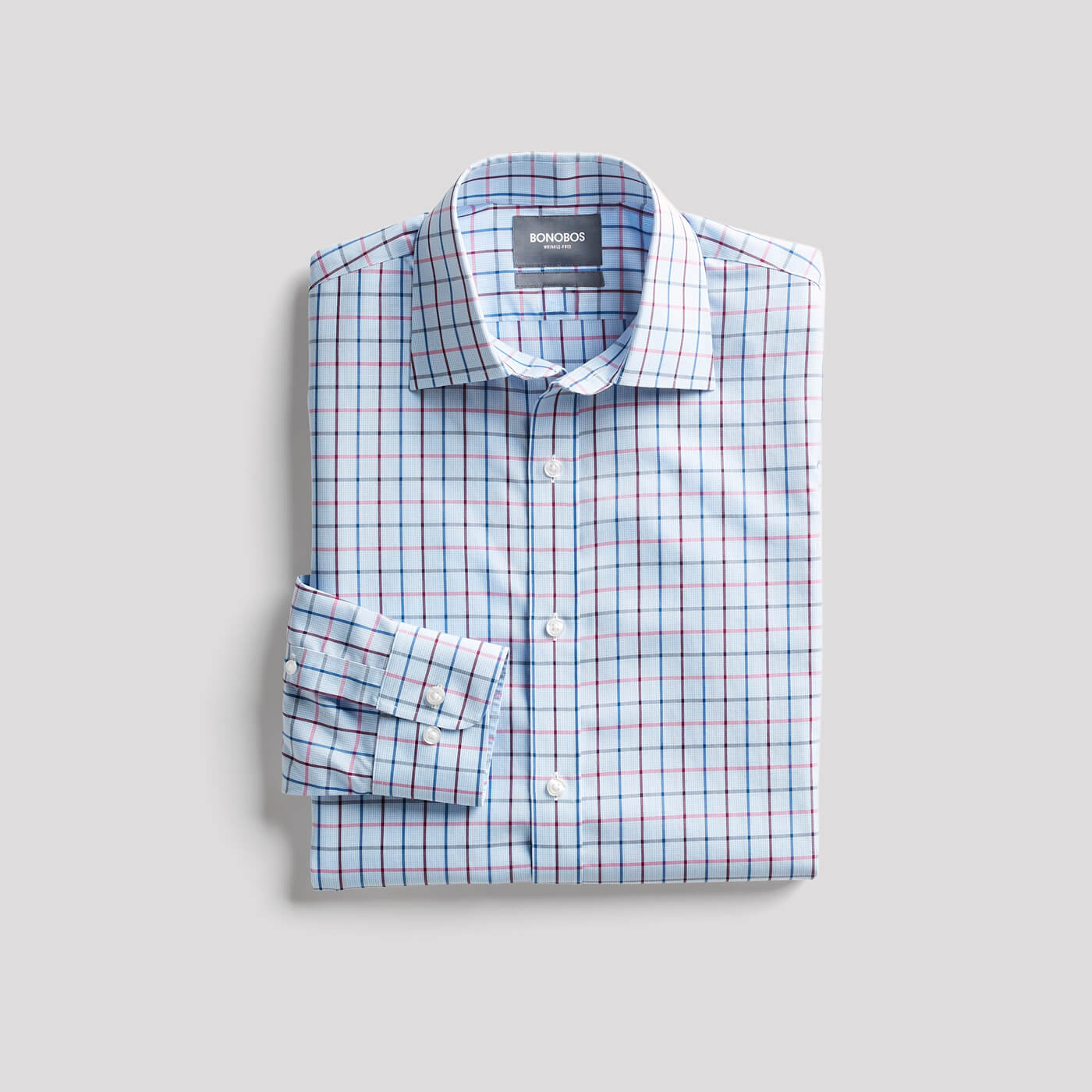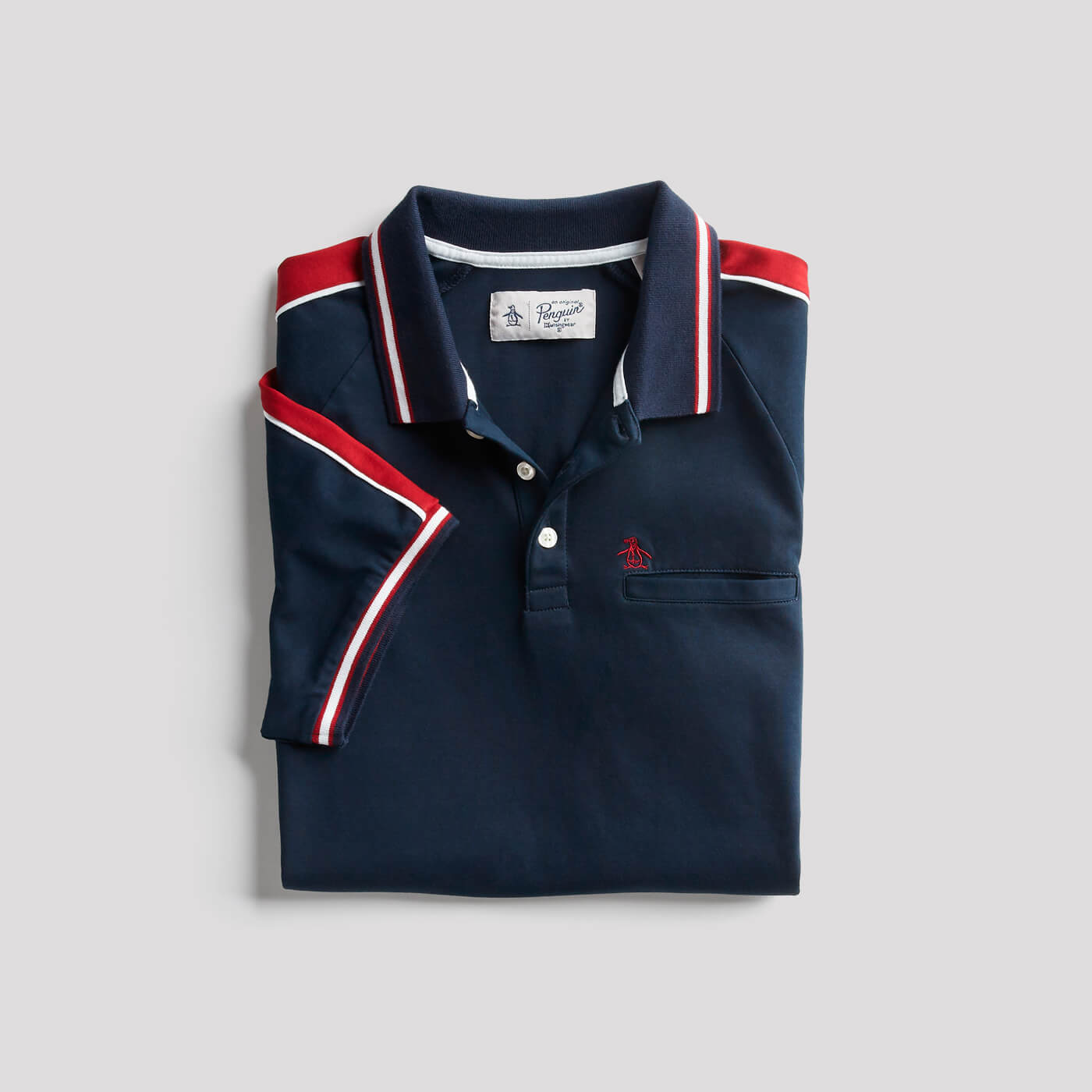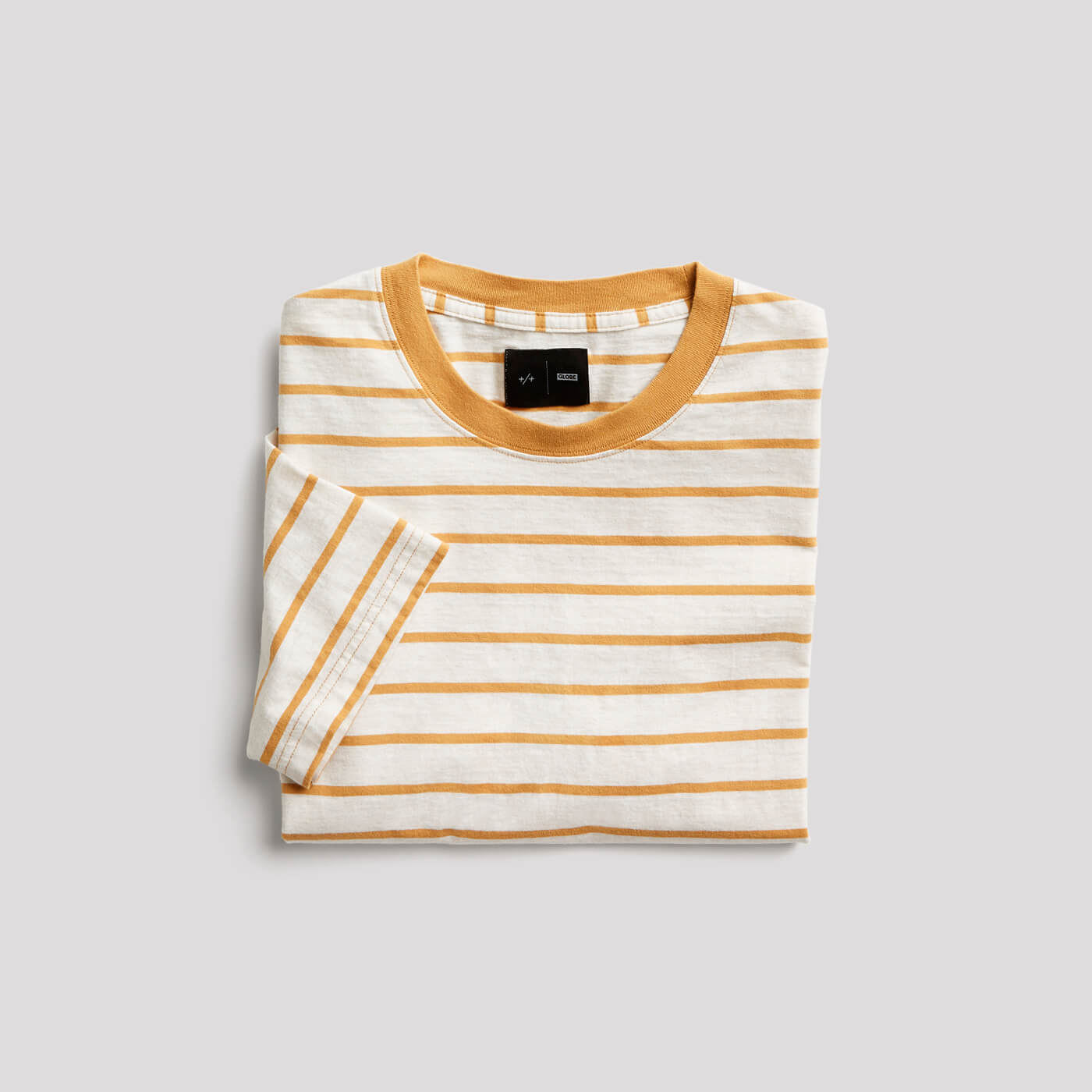Watch, then read, for tips on how to find the right fit in T-shirts, dress shirts and casual shirts.
HOW A T-SHIRT SHOULD FIT
Believe it or not, the T-shirt’s idyllic simplicity is the reason that it’s the most challenging item in your closet as far as fit is concerned. It seems like you should be able to just throw one on and be done with it. However, if it’s too tight, it will cling to you and emphasize your body in the wrong ways—too loose, and it will dangle around you like a nightgown. We’re breaking the T-shirt fit down, bit by bit.
Arms
How to tell if it fits:
Your T-shirt’s sleeves should hit at the midpoint of your upper arm. That said, if you’re tall or have longer arms, longer sleeves will work—just make sure that they don’t extend past your elbows. If you have shorter arms or a lot of muscle definition, shorter sleeves (that hit just above the midpoint of your upper arm) will emphasize your biceps.
How to tell if it doesn’t fit:
If your arms feel like they’re getting lost in the sleeves or the opposite—the end of the sleeves are so tight that they leave marks on your arm—neither is the right fit.
Torso
How to tell if it fits:
Your T-shirt should fall just below your belt and sit right around the middle of where your fly would be. It should also be a close fit. If you’re tall, going oversized might seem like the only way to get the right length, but opt for a longline cut in your size instead. It will hit in the right place without being too billowy.
How to tell if it doesn’t fit:
Even if it’s the right size, any unflattering folds made by extra material is a good indicator that it’s too big. Even if you want a longer-fitting look, it should still fit close to your body. On the other hand, if you raise your arms and see skin, it’s too short.
Shoulders
How to tell if it fits:
This may be the simplest, yet most important step in getting the perfect fit. Your shoulder seam should ideally line up with your actual shoulder bone. That’s it. When your shoulders fit where the seam hits, it looks right, feels right and the sleeves tend to fit better, too.
How to tell if it doesn’t fit:
If the seam goes too high past your shoulder (and is not a raglan style), your sleeves will ride up and feel too snug. If the seam lands somewhere on your upper arm, it will be too big.
Stomach
How to tell if it fits:
You should be able to pinch only a few inches of fabric on either side of your midsection. When in doubt, choose a size up in a slim cut. Apply the same rule for this area of your body as any other—bigger doesn’t mean better. In fact, sometimes going bigger and baggier emphasizes the very things you might be trying to downplay.
How to tell if it doesn’t fit:
Your shirt shouldn’t feel painted on or restrict your natural movements. On the flip side, it shouldn’t drape around you like a mumu.
Neck
How to tell if it fits:
The neckline should lay flat and feel comfortable. It should also be high enough so that any chest hair is covered, unless it’s a V-neck. For V-necks, a flattering neckline won’t show too much skin or be too close to your neck that you find yourself asking, “what’s the point?”.
How to tell if it doesn’t fit:
Any discomfort or inability to move your head comfortably means it’s too tight. If you can pull the neckline over your shoulder easily, it’s too wide. Having said that, there are T-shirts specifically designed with wider necklines, so if you’re going for that trickier look, make sure the shirt fits well everywhere else.

DRESS SHIRTS
An ill-fitting dress shirt can ruin an entire look. It can feel like a chore trying to figure out what factors lead up to a great fit—ending in the chaos of guessing. We’re taking the confusion out of the equation with the following tips.
Arms
How to tell if it fits:
The sleeves should feel just right—not too tight, not too loose. But what does that mean? Since everyone has a different physique, first you have to try on the shirt (and then find a good tailor). A great fit will have a slight taper from the top part of your arm to the cuff. The arm hole will fit, but will not be too tight or loose. There should be about an inch or two between your arm and the fabric. The cuff should hit at the wrist and be a close fit. You can test the length by trying it on with a blazer, making sure you can see some (but not all) of the cuff.
How to tell if it doesn’t fit:
Your mobility will be restrained if the sleeves are too tight. If they’re too loose, the sleeves will swallow your arms, creating a lot of unnecessary folds. Check where the end of the cuff hits—if it extends past or far above your wrist, it won’t be an ideal fit.
Torso
How to tell if it fits:
The buttons should lay flat and there should be about 2-3 inches of extra fabric on each side of your body so that you can move comfortably. Your shirt should be snug, but not tight under your arms and across your back.
How to tell if it doesn’t fit:
The buttons will be pulling and showing your undershirt. Remember, this can happen even if it’s your normal size—and this is where a tailor can help. Another sign it’s a bad fit is if the back of your shirt feels tight when you raise your arms. The back (and maybe front) will also come untucked.
Shoulders
How to tell if it fits:
As mentioned before, the shoulder seam should line up with your shoulder bone. There is no way to hide this if it’s off. Also, if you’re wearing a dress shirt all day, you want it to be comfortable—this is the first step to achieving that.
How to tell if it doesn’t fit:
The size of the arm hole plays a part here because if it’s too small, the shoulder seam will ride up and make the shirt uncomfortable—not to mention result in a visibly bad fit. If the shoulder seam goes past your shoulder and sits on your upper arm, it will look and feel too big.
Stomach
How to tell if it fits:
You want this area to fit well, regardless if you have a 6-pack or not. There should only be a few inches of fabric on either side of your body, but enough so that the buttons lay flat. This means that your pants need to fit too, especially since you’ll probably be tucking in your shirt.
How to tell if it doesn’t fit:
Don’t go with your gut (pun intended). Trying to hide this area by going oversized will make everything appear larger. The opposite would be going too tight, where the buttons are pulling and you’re uncomfortable.
Neck
How to tell if it fits:
It should fit as snug as possible without being uncomfortable. The two-finger rule still applies, and you should be able to fit them in between the fabric and your skin. Also, the back of the collar should conform to the back of your neck.
How to tell if it doesn’t fit:
A few telltale signs: There will be a gap between the collar and your neck, marks start appearing from tightness or you can’t move your head comfortably.

CASUAL BUTTON-DOWN SHIRTS
Casual shirts are the easiest fits to pull off with their fun prints, breezy fabrics and general consensus of ease. However, don’t be fooled into thinking you don’t have to be mindful of a few style tips—and we have them right here.
Arms
How to tell if it fits:
Depending on the type of shirt, you can get away with wider short sleeves. Think vacation styles with boxy cuts. If the sleeves are long, make sure there’s a slight taper from the top part of your arm to the cuff, and not too much excess fabric.
How to tell if it doesn’t fit:
Looser styles still shouldn’t be swallowing your arms. If it’s a knit style, it will naturally hug your biceps more than usual, but watch out for a fit that’s too tight.
Torso
How to tell if it fits:
It should be slightly fitted, but fall straighter than a dress shirt (which tends to curve in). You’ll most likely be wearing it untucked, so the the hem should hit mid-fly—not past it. Casual styles allow for a little more room on either side of your body, around an inch or so more than a dress shirt. A little more room works great for summer, since you don’t want anything clinging to you.
How to tell if it doesn’t fit:
There shouldn’t be so much room that the shirt is shapeless. If it’s so baggy that it sways when you walk, it’s probably too big. The hem also shouldn’t be super long, unless that’s the look you’re going for—and if that’s the case, you should definitely go slimmer.
Shoulders
How to tell if it fits:
Same rule applies as it does for all shirts: Shoulder seams should match up to shoulder bones. There are a few exceptions for casual shirts, such as raglan sleeves, in which case this rule will not apply, but you still don’t want the arm holes to be too wide or tight.
How to tell if it doesn’t fit:
It might be hard to tell since the overall fit of this shirt is loose, but loose or not, a misaligned seam will still fit badly. It will feel too roomy in the arms and back.
Stomach
How to tell if it fits:
Even though it may be a more relaxed style of shirt, the buttons should still lay flat. The drape should be flattering, not oversized. Since you’ll most likely be packing these types of shirts for vacation, you want to make sure it looks good open and not like a shawl.
How to tell if it doesn’t fit:
Too. Much. Room. You’ll be swimming in it if it’s too big, so make sure you’re not trying to camouflage this area. Excess fabric will also add unnecessary weight.
Neck
How to tell if it fits:
Even though casual shirts can have a variety of different collar types (in different materials), apply the same concept as you would to a dress shirt. Your collar should fit snugly, but comfortably, at the neck.
How to tell if it doesn’t fit:
Comfort is key. If it’s too tight or hanging off of your neck, it won’t feel comfortable. This goes for every type of style, from band collars that look good unbuttoned to knit polos that are stretchier.
Ready to expand your wardrobe? Take your style quiz and order a Fix. You’ll have an expert stylist take it from there with a five piece curated Fix. Or, head over to Stitch Fix Freestyle™ to instantly buy pieces curated for your style and size. Try on the pieces in the comfort of your home. Shipping and returns are always free. It’s that easy.
